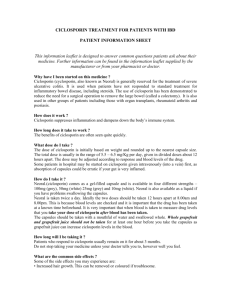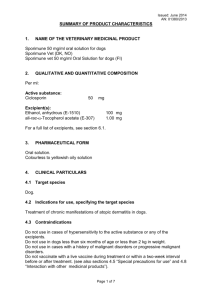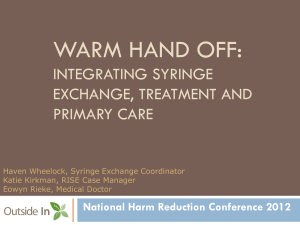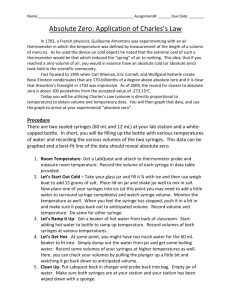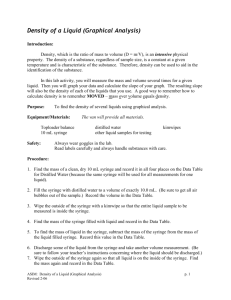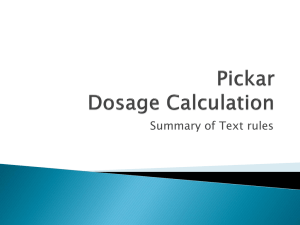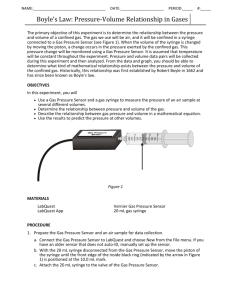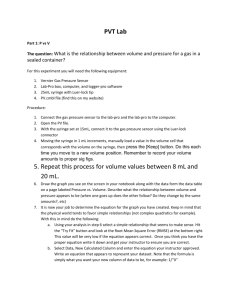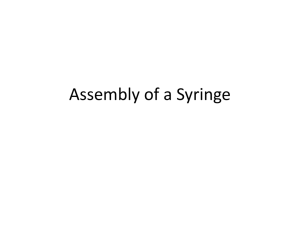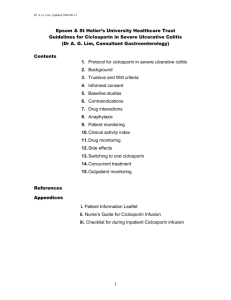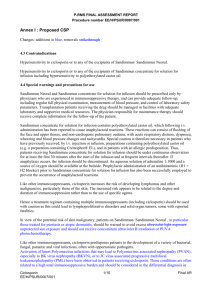2 - Veterinary Medicines Directorate
advertisement
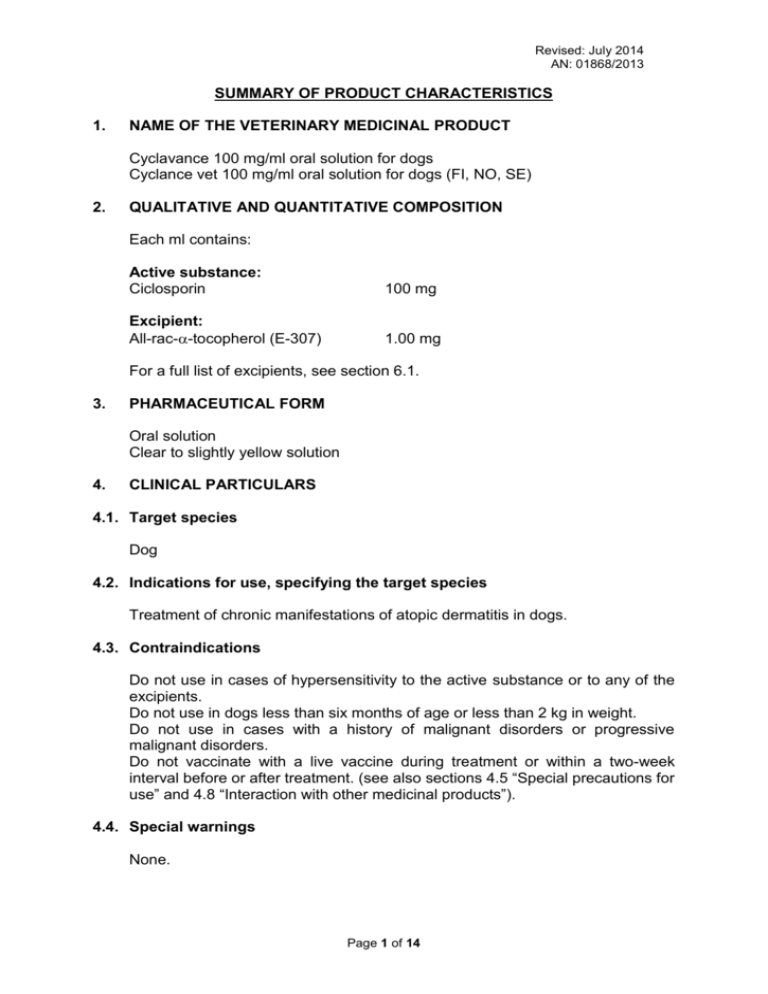
Revised: July 2014 AN: 01868/2013 SUMMARY OF PRODUCT CHARACTERISTICS 1. NAME OF THE VETERINARY MEDICINAL PRODUCT Cyclavance 100 mg/ml oral solution for dogs Cyclance vet 100 mg/ml oral solution for dogs (FI, NO, SE) 2. QUALITATIVE AND QUANTITATIVE COMPOSITION Each ml contains: Active substance: Ciclosporin 100 mg Excipient: All-rac--tocopherol (E-307) 1.00 mg For a full list of excipients, see section 6.1. 3. PHARMACEUTICAL FORM Oral solution Clear to slightly yellow solution 4. CLINICAL PARTICULARS 4.1. Target species Dog 4.2. Indications for use, specifying the target species Treatment of chronic manifestations of atopic dermatitis in dogs. 4.3. Contraindications Do not use in cases of hypersensitivity to the active substance or to any of the excipients. Do not use in dogs less than six months of age or less than 2 kg in weight. Do not use in cases with a history of malignant disorders or progressive malignant disorders. Do not vaccinate with a live vaccine during treatment or within a two-week interval before or after treatment. (see also sections 4.5 “Special precautions for use” and 4.8 “Interaction with other medicinal products”). 4.4. Special warnings None. Page 1 of 14 Revised: July 2014 AN: 01868/2013 4.5. Special precautions for use i) Special precautions for use in animals Clinical signs of atopic dermatitis such as pruritus and skin inflammation are not specific for this disease. Other causes of dermatitis such as ectoparasitic infestations, other allergies which cause dermatological signs (e.g. flea allergic dermatitis or food allergy) or bacterial and fungal infections should be ruled out before treatment is started. It is good practice to treat flea infestations before and during treatment of atopic dermatitis. A complete clinical examination should be performed prior to treatment. While ciclosporin does not induce tumours, it does inhibit T-lymphocytes and therefore treatment with ciclosporin may lead to an increased incidence of clinically apparent malignancy due to the decrease in antitumour immune response. The potentially increased risk of tumour progression must be weighed against the clinical benefit. Lymphadenopathy observed on treatment with ciclosporin should be regularly monitored. It is recommended to clear bacterial and fungal infections before administering the veterinary medicinal product. However, infections occurring during treatment are not necessarily a reason for drug withdrawal, unless the infection is severe. In laboratory animals, ciclosporin is liable to affect the circulating levels of insulin and to cause an increase in glycaemia. If signs of diabetes mellitus are observed following the use of the product, e.g. polyuria, polydipsia, the dose should be tapered or discontinued and veterinary care sought.' In the presence of suggestive signs of diabetes mellitus, the effect of treatment on glycaemia must be monitored. The use of ciclosporin is not recommended in diabetic dogs. Closely monitor creatinine levels with severe renal insufficiency. Particular attention must be paid to vaccination. Treatment with the veterinary medicinal product may interfere with vaccination efficacy. In the case of inactivated vaccines, it is not recommended to vaccinate during treatment or within a two-week interval before or after administration of the product. For live vaccines see also section 4.3 “Contraindications”. It is not recommended to use other immunosuppressive agents concomitantly. ii) Special precautions to be taken by the person administering the veterinary medicinal product to animals Page 2 of 14 Revised: July 2014 AN: 01868/2013 People with known hypersensitivity to ciclosporin should avoid contact with the product. Wash hands after administration. In the event of accidental contact of product with skin or eyes, the affected area should be washed with clean water. In case of accidental ingestion, seek medical advice immediately and show the package leaflet or the label to the physician. 4.6. Adverse reactions (frequency and seriousness) The occurrence of adverse reactions is uncommon. The most frequently observed undesirable effects are gastrointestinal disturbances such as vomiting, mucoid or soft faeces and diarrhoea. They are mild and transient and generally do not require the cessation of the treatment. Other undesirable effects may be observed infrequently: lethargy or hyperactivity, anorexia, mild to moderate gingival hyperplasia, skin reactions such as verruciform lesions or change of hair coat, red and swollen pinnae, muscle weakness or muscle cramps. Mild and transient salivation can be observed following treatment administration. These effects generally resolve spontaneously after treatment is stopped. In very rare cases diabetes mellitus has been observed, especially in West Highland White Terriers. As for the subject of malignancy, please see sections 4.3 “Contraindications” and 4.5 “Special precautions for use”. 4.7. Use during pregnancy, lactation or lay The safety of the drug has neither been studied in male dogs used for breeding nor in pregnant or lactating female dogs. In the absence of such studies, it is recommended to use the drug in breeding dogs only upon a positive risk/benefit assessment by the veterinary surgeon. In laboratory animals, at doses which induce maternal toxicity (rats at 30 mg/kg BW and rabbits at 100 mg/kg BW) ciclosporin was embryo- and foetotoxic, as indicated by increased pre- and postnatal mortality and reduced foetal weight together with skeletal retardations. In the well-tolerated dose range (rats at up to 17 mg/kg BW and rabbits at up to 30 mg/kg BW) ciclosporin was without embryolethal or teratogenic effects. In laboratory animals ciclosporin crosses the placenta barrier and is excreted via milk. Therefore the treatment of lactating bitches is not recommended. Page 3 of 14 Revised: July 2014 AN: 01868/2013 4.8. Interaction with other medicinal products and other forms of interaction Various substances are known to competitively inhibit or induce the enzymes involved in the metabolism of ciclosporin, in particular cytochrome P450 (CYP 3A 4). In certain clinically justified cases, an adjustment of the dosage of the veterinary medicinal product may be required. The compound class of azoles (e.g. ketoconazole) is known to increase the blood concentration of ciclosporin, which is considered to be clinically relevant. Ketoconazole at 5-10 mg/kg is known to increase the blood concentration of ciclosporin in dogs up to five-fold. During concomitant use of ketoconazole and ciclosporin the veterinarian should consider as a practical measure to double the treatment interval if the dog is on a daily treatment regime. Macrolides such as erythromycin may increase the plasma levels of ciclosporin up to twofold. Certain inducers of cytochrome P450, anticonvulsants and antibiotics (e.g. trimethoprim/ sulfadimidine) may lower the plasma concentration of ciclosporin. Ciclosporin is a substrate and an inhibitor of the MDR1 P-glycoprotein transporter. Therefore, the co-administration of ciclosporin with P-glycoprotein substrates such as macrocyclic lactones, e.g. ivermectin and milbemycin, could decrease the efflux of such drugs from blood-brain barrier cells, potentially resulting in signs of CNS toxicity. Ciclosporin can increase the nephrotoxicity of aminoglycoside antibiotics and trimethoprim. The concomitant use of ciclosporin is not recommended with these active ingredients. Particular attention must be paid to vaccination (see section 4.3 “Contraindications” and 4.5 “Special precautions for use”) and to concomitant use of other immunosuppressive agents (see section 4.5 “Special precautions for use”). 4.9. Amounts to be administered and administration route For oral use. The recommended dose of ciclosporin is 5 mg/kg body weight (0.05 ml of oral solution per kg BW) and should initially be administered daily. The frequency of administration should subsequently be reduced depending on the response. Page 4 of 14 Revised: July 2014 AN: 01868/2013 DOSAGES PRIMARY PACKAGING TYPE 1 For the 5 and 15 ml vials (1 ml syringe graduated every 0.05 ml) At standard dosage of 5mg/kg Volume to be administered: 0.05 ml/kg Weight (kg) Dosage (ml) 2 3 4 5 6 7 8 9 10 11 12 13 14 15 16 17 18 19 20 0.1 0.15 0.2 0.25 0.3 0.35 0.4 0.45 0.5 0.55 0.6 0.65 0.7 0.75 0.8 0.85 0.9 0.95 1 Weight (kg) Dosage (ml) 21 22 23 24 25 26 27 28 29 30 31 32 33 34 35 36 37 38 39 40 1.05 1.1 1.15 1.2 1.25 1.3 1.35 1.4 1.45 1.5 1.55 1.6 1.65 1.7 1.75 1.8 1.85 1.9 1.95 2 Weight (kg) Dosage (ml) 41 42 43 44 45 46 47 48 49 50 51 52 53 54 55 56 57 58 59 60 2.05 2.1 2.15 2.2 2.25 2.3 2.35 2.4 2.45 2.5 2.55 2.6 2.65 2.7 2.75 2.8 2.85 2.9 2.95 3 Weight (kg) Dosage (ml) 61 62 63 64 65 66 67 68 69 70 71 72 73 74 75 76 77 78 79 80 3.05 3.1 3.15 3.2 3.25 3.3 3.35 3.4 3.45 3.5 3.55 3.6 3.65 3.7 3.75 3.8 3.85 3.9 3.95 4 For the 30 and 60 ml vials (2 ml syringe graduated every 0.1 ml) At standard dosage of 5mg/kg Volume to be administered: 0.1 ml/2kg Weight (kg) Dosage (ml) 2 4 6 8 10 12 14 16 18 0.1 0.2 0.3 0.4 0.5 0.6 0.7 0.8 0.9 20 1 22 24 26 28 30 32 34 36 38 1.1 1.2 1.3 1.4 1.5 1.6 1.7 1.8 1.9 40 2 Weight (kg) Dosage (ml) 42 44 46 48 50 52 54 56 58 2.1 2.2 2.3 2.4 2.5 2.6 2.7 2.8 2.9 60 3 62 64 66 68 70 72 74 76 78 3.1 3.2 3.3 3.4 3.5 3.6 3.7 3.8 3.9 80 4 Page 5 of 14 Revised: July 2014 AN: 01868/2013 PRIMARY PACKAGING TYPE 2 For the 5 and 15 ml vials (1 ml syringe graduated every 0.05 ml) At standard dosage of 5mg/kg Volume to be administered: 0.05 ml/kg Weight (kg) Dosage (ml) 2 3 4 5 6 7 8 9 10 11 12 13 14 15 16 17 18 19 20 0.1 0.15 0.2 0.25 0.3 0.35 0.4 0.45 0.5 0.55 0.6 0.65 0.7 0.75 0.8 0.85 0.9 0.95 1 Weight (kg) Dosage (ml) 21 22 23 24 25 26 27 28 29 30 31 32 33 34 35 36 37 38 39 40 1.05 1.1 1.15 1.2 1.25 1.3 1.35 1.4 1.45 1.5 1.55 1.6 1.65 1.7 1.75 1.8 1.85 1.9 1.95 2 Weight (kg) Dosage (ml) 41 42 43 44 45 46 47 48 49 50 51 52 53 54 55 56 57 58 59 60 2.05 2.1 2.15 2.2 2.25 2.3 2.35 2.4 2.45 2.5 2.55 2.6 2.65 2.7 2.75 2.8 2.85 2.9 2.95 3 Weight (kg) Dosage (ml) 61 62 63 64 65 66 67 68 69 70 71 72 73 74 75 76 77 78 79 80 3.05 3.1 3.15 3.2 3.25 3.3 3.35 3.4 3.45 3.5 3.55 3.6 3.65 3.7 3.75 3.8 3.85 3.9 3.95 4 For the 30 and 50 ml vials (3 ml syringe graduated every 0.1 ml) At standard dosage of 5mg/kg Volume to be administered: 0.1 ml/2kg Weight (kg) Dosage (ml) 2 4 6 8 10 12 14 16 18 0.1 0.2 0.3 0.4 0.5 0.6 0.7 0.8 0.9 20 1 22 24 26 28 30 32 34 36 38 1.1 1.2 1.3 1.4 1.5 1.6 1.7 1.8 1.9 40 2 Weight (kg) Dosage (ml) 42 44 46 48 50 52 54 56 58 2.1 2.2 2.3 2.4 2.5 2.6 2.7 2.8 2.9 60 3 62 64 66 68 70 72 74 76 78 3.1 3.2 3.3 3.4 3.5 3.6 3.7 3.8 3.9 80 4 Page 6 of 14 Revised: July 2014 AN: 01868/2013 Before starting treatment, an evaluation of all alternative treatment options should be made. The product should initially be given daily until a satisfactory clinical improvement is seen. This will generally be the case within 4-8 weeks. If no response is obtained within the first 8 weeks, the treatment should be stopped. Once the clinical signs of atopic dermatitis are satisfactorily controlled, the product can then be given every second day. The veterinarian should perform a clinical assessment at regular intervals and adjust the frequency of administration to the clinical response obtained. In some cases where the clinical signs are controlled with every second day dosing, the veterinary surgeon can decide to give the product every 3 to 4 days. The lowest effective frequency of dosing should be used to maintain the remission of clinical signs. Patients should be regularly re-evaluated and alternative treatment options reviewed. Adjunct treatment (e.g. medicated shampoos, fatty acids) may be considered before reducing the dosing interval. The duration of treatment should be adjusted according to treatment response. Treatment may be stopped when the clinical signs are controlled. Upon recurrence of clinical signs, treatment should be resumed at daily dosing, and in certain cases repeated treatment courses may be required. The veterinary medicinal product should be given at least 2 hours before or after feeding. Insert the syringe directly into the dog’s mouth. Page 7 of 14 Revised: July 2014 AN: 01868/2013 INSTRUCTIONS FOR USE The veterinary medicinal product should be given at least 2 hours before or after feeding. Insert the syringe directly into the dog’s mouth. PRIMARY PACKAGING TYPE 1 1 Push and turn the child-resistant screw cap to open the bottle. 2 Keep the bottle upright and insert the oral dosing syringe firmly into the plastic adapter. Always close the bottle with the child-resistant screw cap after use. 3 Turn the bottle upside down and slowly pull the plunger up so that the oral dosing syringe fills with the product. Withdraw the dose of medicine prescribed by your veterinarian. 4 Return the bottle to its upright position and remove the oral dosing syringe by gently twisting it out of the plastic adapter. Page 8 of 14 Revised: July 2014 AN: 01868/2013 5 You can now introduce the syringe in the mouth of your dog 6 Always close the bottle with the and push the medicine out of the syringe. Do not rinse or clean the oral dosing syringe between uses. child-resistant screw cap after use. To provide a child-resistant closure, push down on the child-resistant screw cap as you turn it. Note: If the prescribed dose is more than the maximum volume marked on the oral dosing syringe, you will need to reload the syringe to withdraw the full dose. Page 9 of 14 Keep out of the sight and reach of children Revised: July 2014 AN: 01868/2013 PRIMARY PACKAGING TYPE 2 1 Retrieve the plastic cap and insert firmly the plastic dispenser. 2 Keep the bottle upright and insert the oral dosing syringe firmly into the plastic dispenser. The plastic dispenser should remain in place. 3 Turn the bottle upside down and slowly pull the plunger up so that the oral dosing syringe fills with the product. Withdraw the dose of medicine prescribed by your veterinarian. Return the bottle to its upright position and remove the oral dosing syringe by gently twisting it out of the plastic dispenser. 4 You can now introduce the syringe in the mouth of your dog and push the medicine out of the syringe. Do not rinse or clean the oral dosing syringe between uses. Note: If the prescribed dose is more than the maximum volume marked on the oral dosing syringe, you will need to reload the syringe to withdraw the full dose. Keep out of the sight and reach of children If necessary, the user can wipe the outside of the syringe with a dry tissue and dispose of used tissue immediately. Page 10 of 14 Revised: July 2014 AN: 01868/2013 4.10. Overdose (symptoms, emergency procedures, antidotes), if necessary No undesirable effects beyond those that were seen under recommended treatment have been observed in the dog with a single oral dose of up to 6 times of what is recommended. In addition to what was seen under recommended dosage, the following adverse reactions were seen in case of overdose for 3 months or more at 4 times the mean recommended dosage: hyperkeratotic areas especially on the pinnae, callous-like lesions of the foot pads, weight loss or reduced weight gain, hypertrichosis, increased erythrocyte sedimentation rate, decreased eosinophil values. Frequency and severity of these signs are dose dependent. There is no specific antidote and in case of signs of overdose the dog should be treated symptomatically. The signs are reversible within 2 months following cessation of treatment. 4.11. Withdrawal period Not applicable. 5. PHARMACOLOGICAL PROPERTIES Pharmacotherapeutic group: Antineoplastic and immunomodulating agents, immunosuppressants, calcineurin inhibitors, ciclosporin. ATCvet code: QL04AD01. 5.1. Pharmacodynamic properties Ciclosporin (also known as cyclosporin, cyclosporine, cyclosporine A, CsA) is a selective immunosuppressor. It is a cyclic polypeptide consisting of 11 amino acids, has a molecular weight of 1203 daltons and acts specifically and reversibly on T lymphocytes. Ciclosporin exerts anti-inflammatory and antipruritic effects in the treatment of atopic dermatitis. Ciclosporin has been shown to preferentially inhibit the activation of T-lymphocytes on antigenic stimulation by impairing the production of IL-2 and other T-cell derived cytokines. Ciclosporin also has the capacity to inhibit the antigen-presenting function of the skin immune system. It likewise blocks the recruitment and activation of eosinophils, the production of cytokines by keratinocytes, the functions of Langerhans cells, the degranulation of mast cells and therefore the release of histamine and pro-inflammatory cytokines. Ciclosporin does not depress haematopoiesis and has no effect on the function of phagocytic cells. Page 11 of 14 Revised: July 2014 AN: 01868/2013 5.2. Pharmacokinetic particulars Absorption The bioavailability of ciclosporin is about 35%. The peak plasma concentration is reached within 1 to 2 hours. The bioavailability is better and less subject to individual variations if ciclosporin is administered to fasted animals rather than at mealtimes. Distribution The volume of distribution is about 7.8 L/kg. Ciclosporin is widely distributed to all tissues. Following repeated daily administration to dogs ciclosporin concentration in the skin is several times higher than in blood. Metabolism Unchanged ciclosporin represents about 25% of circulating blood concentrations in the course of the first 24 hours. Ciclosporin is metabolised mainly in the liver by cytochrome P450 (CYP 3A 4), but also in the intestine. Metabolism takes place essentially in the form of hydroxylation and demethylation, leading to metabolites with little or no activity. Elimination Elimination is mainly via the faeces. Only 10% is excreted in the urine, mostly in the form of metabolites. No significant accumulation was observed in blood of dogs treated for one year. 6. PHARMACEUTICAL PARTICULARS 6.1. List of excipients all-rac--Tocopherol (E-307) Glycerol monolinoleate Ethanol, anhydrous (E-1510) Macrogolglycerol hydroxystearate Propylene glycol (E-1520) 6.2. Incompatibilities In the absence of compatibility studies, this veterinary medicinal product must not be mixed with other veterinary medicinal products. 6.3. Shelf life Shelf-life of the veterinary medicinal product as packaged for sale: 2 years. Shelf-life after first opening the immediate packaging: 6 months. Page 12 of 14 Revised: July 2014 AN: 01868/2013 6.4. Special precautions for storage Do not refrigerate. A jelly-like formation may occur below 15°C which is however reversible at temperatures up to 25°C without affecting the quality of the product. After first opening: Do not store above 25C. 6.5. Nature and composition of immediate packaging Packaging 1: Amber glass (type III) bottles closed with a child resistant HDPE screw cap including a plastic adapter (HDPE). 5 ml bottle, with a dispenser set consisting of a 1 ml PE syringe increments of 0.05 ml, packaged in a cardboard box. 15 ml bottle, with a dispenser set consisting of a 1 ml PE syringe increments of 0.05 ml, packaged in a cardboard box. 30 ml bottle, with a dispenser set consisting of a 2 ml PE syringe increments of 0.1 ml, packaged in a cardboard box. 60 ml bottle, with a dispenser set consisting of a 2 ml PE syringe increments of 0.1 ml, packaged in a cardboard box. graduated in graduated in graduated in graduated in Packaging 2: Amber glass (type III) bottles closed with a 20 mm bromobutyl stopper and an aluminum cap with flip-off. 5 ml bottle with a dispenser set consisting of a polycarbonate dispenser cap with a silicone valve and a 1 ml polycarbonate syringe graduated in increments of 0.05 ml, packaged in a cardboard box. 15 ml bottle with a dispenser set consisting of a polycarbonate dispenser cap with a silicone valve and a 1 ml polycarbonate syringe graduated in increments of 0.05 mL, packaged in a cardboard box. 30 ml bottle, with a dispenser set consisting of a polycarbonate dispenser cap with a silicone valve and a 3 ml polypropylene syringe graduated in increments of 0.1 ml, packaged in a cardboard box. 50 ml bottle, with a dispenser set consisting of a polycarbonate dispenser cap with a silicone valve and a 3 ml polypropylene syringe graduated in increments of 0.1 ml, packaged in a cardboard box. Not all pack sizes may be marketed. 6.6. Special precautions for the disposal of unused veterinary medicinal product or waste materials derived from the use of such products Any unused veterinary medicinal product or waste materials derived from such veterinary medicinal product should be disposed of in accordance with local requirements. Page 13 of 14 Revised: July 2014 AN: 01868/2013 7. MARKETING AUTHORISATION HOLDER VIRBAC 1ère avenue – 2065 m – L.I.D. 06516 Carros France 8. MARKETING AUTHORISATION NUMBER Vm: 05653/4180 9. DATE OF FIRST AUTHORISATION Date: 03 April 2014 10. DATE OF REVISION OF THE TEXT Date: July 2014 21 August 2014 Page 14 of 14
